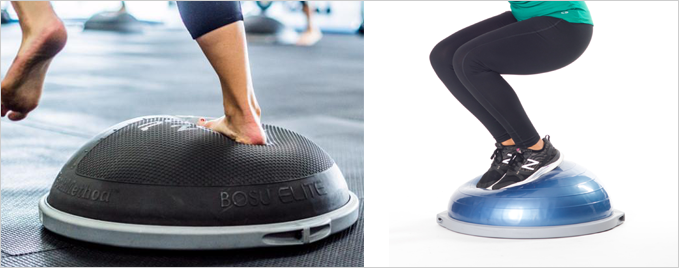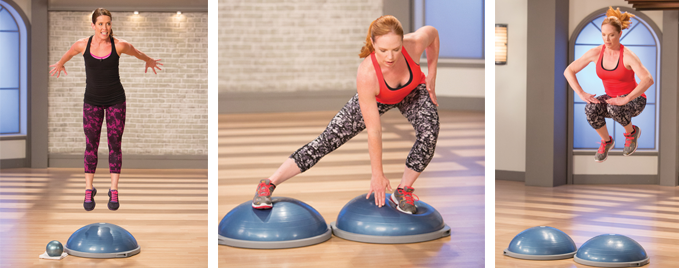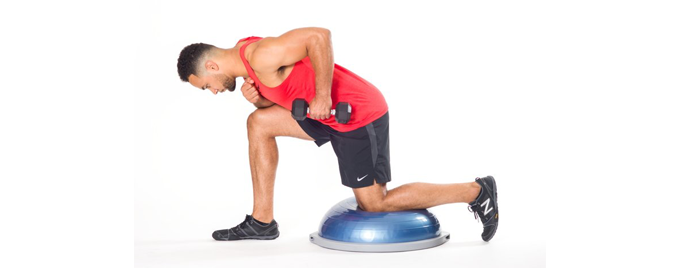Using Functional Balance Exercises to Customize Workouts
Altering a workout in new and creative ways is essential to keeping clients interested. The BOSU Balance Trainer is designed to permit such flexibility. The number of exercise variations is unlimited. What matters most is the user/instructor knows exactly how to alter and diversify balance exercises to maintain interest. This way, the user won't lose interest due to exercises being repetitive and easy or grow frustrated to the point that he or she quits because the exercise is too challenging. Above all, BOSU training should be suited to each participant's unique skill level. Mastering the nuances of this system are essential to ensure training session safety. Furthermore, developing a full understanding of how to alter exercises makes it that much easier to pinpoint areas for improvement and provide instructors with a never-ending number of workouts.
The Four Balance Challenge Variables
A complete workout system is centered on four balance challenge variables: contact points, movement, visual affect and external stimulus. Each of these variables can be used together or individually to generate a seemingly endless number of exercises. The mastery of these four variables requires a thorough understanding of how they function with each BOSU exercise. Once this mastery is accomplished, the system will be truly optimized. Let's take a closer look at these variables to understand how they are used to influence exercising.

Contact Points
Contact points are a reference to things supporting the body while exercising on the Balance Trainer. Contact points reference body parts ranging from the feet to the hands, hips and knees that stay in contact with the Balance Trainer or the ground when balancing. Contact points can also refer to surface area or pieces of equipment that provide support.
Anything from the floor to a wall or a body bar can be used to enhance balance. Using more contact points makes it that much easier to to complete the exercise while fewer contact points makes the exercise that much more difficult. As an example, a one-arm front raise performed while standing on the dome will prove especially challenging if it is done on a single foot as opposed to two feet.
Visual Affect
Altering the feedback from the eyes has a major affect on one's performance. Once the eyes close during physical activity, be it on a stable surface or an unstable one, makes the activity that much more dangerous. Visibility and the areas in which the eyes focus (known as the focal point) are the basics of visual affect. When you close your eyes during an activity, it stimulates the sensory receptor systems or proprioceptive systems as visual feedback is no longer present.
Visibility can also be eliminated or reduced by a number of other factors. As an example, visibility can be affected by anything from tearing due to strong wind, dim light or darkness that reduces depth perception, fogged glasses, glaucoma and so on. Properly training this portion of proprioception with something like the Balance Trainer empowers the body to react to balance challenges that occur with limited visibility. Balance challenges with visibility serving as a variable should be conducted in an array of positions from sitting to standing, kneeling, supine, prone etc.

Movement is a Balance Variable
The more range of motion used makes the Balance Trainer exercise that much more difficult to execute. Less movement makes movement challenges significantly easier. As an example, flexing a supporting leg and tapping the opposing foot on the dome can regress a side lunge. Note that the tapping of the opposite foot occurred along the dome instead of the floor. The arm can be in the regular stationary position The lunge can then be progressed with a loading of the supporting leg into flexion and moving the leg that lunges out to the side. Movement can be implemented with a dynamic reach across the body with the other arm.
Aside from changing the range of motion, other locomotor skills can be implemented in regular exercises to make them that much more grueling. As an example, a bicep curl done while on the Balance Trainer in the standing position can be made that much more difficult with the addition of a squat motion. Perform the squat as you perform the curl. The degree of motion implemented makes the challenge that much more dynamic. You can limit the range of motion to a couple degrees of the knee, hip or ankle flexion amidst the squat. You can also perform the squat with a complete range of motion for that much more difficult of a challenge. For example, a small range of motion along with stationary arms during a side lunge simplifies the exercise. A comparably large range of motion along with dynamic arm movement makes lunges that much more difficult.
You can vary lower body exercises like lunges and squats to form multi-region exercises. All you have to do is add the proper core-based and upper body movements. The speed or cadence of the movement can be varied to heighten or reduce the difficulty. You can forward lunge onto the dome of the Balance Trainer with a minor range of motion, stationary arms and a fairly quick cadence. This means less time will be spent holding the balanced position amidst the lunge.
The forward lunge can be made even more difficult with an increase in the range of motion, an increase in the time on the dome and the addition of a lateral raise with your arms. Consider implementing a minor range of motion squat to your bicep curls for more of a challenge. A bicep curl performed with a full range of motion squat demands considerable strength and balance

External Stimulus
External stimuli are outside forces exerted amidst an exercise. Anything from adding dumbbells to tossing a fitness ball or a push-pull force applied by a trainer qualifies as an external stimulus. The introduction or subtraction of an outside force has the potential to make BOSU exercises more or less difficult, enjoyable and exciting.
As an example, catching a fitness ball while performing a core exercise is certainly an external stimulus that makes the muscular effort more difficult. The individual must adjust his or her center of gravity after reacting to the stimulus. This inherently makes the exercise more challenging. The bottom line is external stimuli make all BOSU exercises limitless in terms of potential forms, purposes and dynamics.
Additional Resources: BOSU Balance Trainer Guide
Related Content:
Empower your staff and reassure your community with our FREE downloadable cleaning and disinfecting guides for fitness centers, educational settings, hospitality facilities and more.
Topics from this blog: Training Tips
Back


